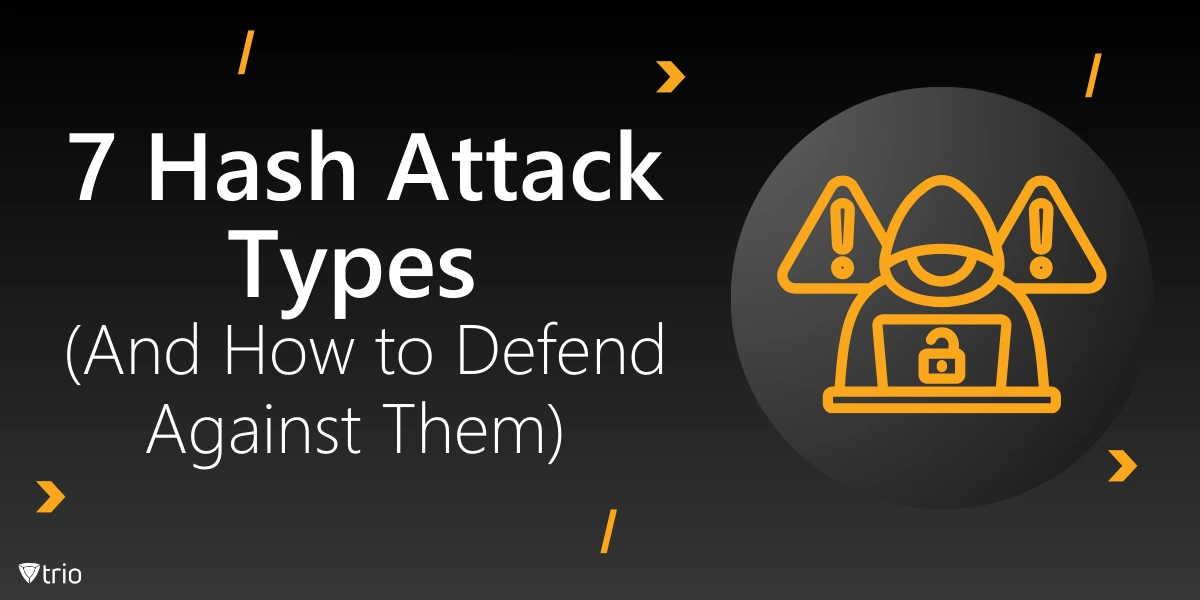Hash functions play a pivotal role in cybersecurity, acting as the silent guardians of data integrity and authentication. They transform data into fixed-size strings of characters, which are nearly impossible to reverse-engineer. However, as cyber threats evolve, grasping the intricacies of hash attack types in cybersecurity is becoming increasingly important for protecting modern digital environments. Effective vulnerability management is crucial in identifying weaknesses that could be exploited by these attacks.
With the rise of sophisticated cyber attacks, endpoint security solutions are now focusing on reinforcing these functions to prevent data breaches and unauthorized access. In defending against hash attacks, endpoint security means keeping end-user devices safe, preventing unauthorized access, and ensuring that all data processed through these endpoints remains uncompromised.
IT admins need to stay ahead of hash attack types to safekeep organizational data. Knowing evolving threats are targeting hash functions, you can implement strong security measures that help you against potential vulnerabilities and keep your network secure.
What Are Hash Functions?
A hash function is a mathematical algorithm that converts input data into a fixed-size string of characters, which appears random. This process is deterministic and one-way, meaning the same input will always produce the same output. However, the original input cannot be easily retrieved from the hash.
Hash functions are commonly used for password storage to ensure that even if a database is compromised, the actual passwords remain protected. They also play a significant role in data integrity verification and digital signatures. Hash functions are utilized to confirm that data has not been altered during transmission.
The 7 Hash Attack Types
An IT admin looking to strengthen cybersecurity defenses should be aware of the different types of attacks on hash functions. Let’s see these hash attack types examples to find out how attackers exploit these functions and what can be done to prevent them.

1- Brute Force Attacks
In a brute force attack, cybercriminals systematically try every possible combination of characters to uncover the original input behind a hash. This method exploits the fact that some passwords are shorter and less complex, which makes them easier to crack.
While time-consuming, brute force attacks can be effective against weak passwords. If an attacker has enough computational power, even moderately complex passwords can eventually be compromised, leading to unauthorized access to sensitive data.
To defend against brute force attacks, you have to encourage the use of complex passwords that combine letters, numbers, and special characters. Implementing account lockout policies after a certain number of failed attempts can also deter attackers.
2- Dictionary Attacks
Dictionary attacks operate much like a determined treasure hunt through a predictable set of common passwords. Attackers use a precompiled list of popular words and passwords, relying on people’s consistent love for the classics like “password” or “123456.” It’s as if they’re banking on the fact that nobody could possibly be that predictable (and yet, many are). With 300 billion passwords in circulation globally as of this year according to Cybersecurity Ventures, one might think that creativity would flourish—but, alas, it appears that some individuals still prefer using “password1” as if adding a solitary number is a masterstroke of security genius.
This attack exploits users who select simple, common passwords that are readily available in password dictionaries. It significantly reduces the time needed to crack a password compared to brute force methods.
Enforce strong password policies that require a mix of uppercase and lowercase letters, numbers, and special characters. Additionally, ban commonly used passwords to ensure users choose more secure options. Regular password updates and enforcing unique passwords can help mitigate the risk of dictionary attacks.
3- Rainbow Table Attacks
Rainbow table attacks involve the use of precomputed tables to reverse cryptographic hash functions. These tables map hashes back to their original plaintext inputs and significantly speed up the cracking process. Unlike brute force attacks, which generate hashes in real-time, rainbow tables allow attackers to leverage prior computation to expedite the attack process.
Rainbow tables reduce the time needed to crack hashes by eliminating the need to compute the hash of every possible password on the fly. This efficiency makes them a potent tool in compromising systems.
Implement salting to make each hash unique, thereby thwarting rainbow table attacks. Additionally, utilize security assessment tools to regularly check for vulnerabilities in your hashing mechanisms. Salting combined with key stretching can create additional computational barriers, making it even more challenging for attackers to succeed.
4- Collision Attacks
Collisions occur when two different inputs produce the same hash output, which undermines the hash function’s uniqueness. This vulnerability can be exploited to deceive systems that rely on hashes for data integrity.
Attackers can find collisions to subvert data integrity checks. This weakness allows them to substitute malicious data without detection. This can lead to unauthorized transactions or the spread of malware. Additionally, collision attacks can undermine the reliability of digital signatures, leading to fraudulent activities.
To effectively guard against collision vulnerabilities, use hash functions resistant to collisions, such as SHA-256 or SHA-3. Upgrading from older algorithms like MD5 or SHA-1 is really beneficial, as these outdated hashes are more susceptible to attacks. These older algorithms make effective cyber threat management much harder.
5- Length Extension Attacks
Length extension attacks exploit certain hash functions by allowing attackers to append additional data to a hash without knowing the original input. This is possible because of the way some algorithms process data in blocks. These attacks can allow malicious actors to forge signatures or manipulate data integrity checks.
Algorithms like MD5 and SHA-1, as mentioned before, are particularly vulnerable to length extension attacks. Their design allows attackers to manipulate hashes in ways that can compromise security. Moving away from these outdated algorithms to stronger options like SHA-256 is essential for reducing susceptibility to such attacks.
Use HMAC (Hash-based Message Authentication Code) for message authentication to prevent length extension attacks. HMAC adds an extra layer of security by incorporating a secret key into the hashing process, aligning with best practices in a cybersecurity incident response plan.
6- Birthday Attacks
Birthday attacks leverage the birthday paradox, a probability theory concept that makes finding two inputs with the same hash easier than expected. This reduces the computational effort needed to find collisions. The concept relies on the surprising probability that in a relatively small set, two elements might have matching hashes. This makes such attacks feasible even when dealing with otherwise strong hash functions.
Exploiting this paradox, attackers can significantly reduce the complexity of finding collisions in a hash function. This can compromise data integrity and authentication processes. Such vulnerabilities can undermine encrypted communications and help attackers intercept or alter messages. Additionally, they can facilitate unauthorized access.
Employ hash functions with larger output sizes, such as SHA-256 or SHA-3, to make birthday attacks computationally infeasible. Adding extra complexity to the hashing process guarantees that attackers face a significant computational challenge, so the likelihood of successful collisions is reduced.
7- Pass-the-Hash Attacks
In pass-the-hash attacks, attackers use stolen hash values to authenticate themselves on a network without cracking the actual passwords. This method exploits weaknesses in authentication protocols. It can be particularly effective in environments where weak credential handling practices are in place.
Such attacks can lead to full domain compromise, especially in Windows environments where hash values can be extracted from memory. This weakness poses a significant threat to network security. Attackers who successfully pass the hash can move laterally within the network, gaining access to critical systems. Once inside, they can elevate their privileges and expand their reach and control over the compromised network.
Limit hash exposure by restricting administrative privileges and using multi-factor authentication. Implementing multi-factor authentication provides you with an extra security measure and makes it harder for attackers to gain unauthorized access.
Defending Against Hash Attacks
Hash functions play a role in maintaining data security, but they are not without their vulnerabilities. In this section, we’ll explore measures you can take to defend against various hash attack types.

Implement Strong Hash Functions
Transition to strong algorithms like SHA-256 or SHA-3 to enhance security. These functions are less susceptible to attacks and provide you with a stronger defense against potential breaches. It’s also important to phase out older, vulnerable algorithms systematically across all systems to minimize potential weaknesses.
Use Salting and Peppering
Adding random data, or “salt,” to passwords before hashing makes each hash unique, thwarting rainbow table attacks. Peppering involves using a secret value added to the hashing process. Additionally, ensuring salts are unique and sufficiently long helps make these protections even more effective.
Key Stretching Techniques
Utilize algorithms like bcrypt, scrypt, or Argon2 to implement key stretching. These techniques slow down attackers by increasing the computational time required to crack each hash. Integrating these key stretching algorithms into existing systems is required to make sure that attackers face significant difficulty when attempting brute-force attacks.
Regularly Update Security Protocols
Stay informed about vulnerabilities in current hash functions and update your systems accordingly. Using tools regarding hash attack types can help identify and address weaknesses before they are exploited. Regular internal security audits and penetration testing can also help in keeping protocols updated and effective against emerging threats.
Best Practices
You should implement key best practices that help prevent potential vulnerabilities. The following strategies focus on enforcing password policies, enhancing user education, and leveraging multi-factor authentication to strengthen overall cybersecurity.
- Enforce Strong Password Policies: Require passwords that are complex, unique, and regularly updated. This reduces the risk of successful brute force and dictionary attacks.
- Educate Users: Conduct training sessions to inform users about the importance of password security and the risks associated with weak credentials. Implement Multi-Factor Authentication (MFA): Adding an extra layer of security beyond passwords makes unauthorized access significantly more difficult for attackers.
- Monitor and Audit Systems: Regularly check for unauthorized access and unusual activities. Keeping logs and conducting audits can help detect and respond to threats promptly.
Elevate Security With Trio
Mobile Device Management (MDM) is directly related to endpoint security, which is critical in defending against hash attacks. By securing devices and managing access, MDM solutions help prevent unauthorized activities that could compromise hash functions.
Our MDM product, Trio, offers comprehensive security features that align with the best practices discussed. It helps enforce strong password policies, implement multi-factor authentication, and monitor devices for unusual activities. We invite you to try our free demo to see how Trio can bolster your security posture.
Conclusion
Understanding and defending against different types of hash attacks is needed in today’s changing cyber landscape. IT admins can implement strategies to protect organizational data effectively by recognizing these threats.
Cyber threats are continually advancing, so it is imperative to stay informed about the latest attack methods and defense mechanisms. Regularly updating your knowledge and systems is conducive to maintaining security.
We encourage you to take measures and explore solutions like Trio to enhance your organization’s security posture. Protecting your data starts with understanding the risks and implementing comprehensive defenses.
Get Ahead of the Curve
Every organization today needs a solution to automate time-consuming tasks and strengthen security.
Without the right tools, manual processes drain resources and leave gaps in protection. Trio MDM is designed to solve this problem, automating key tasks, boosting security, and ensuring compliance with ease.
Don't let inefficiencies hold you back. Learn how Trio MDM can revolutionize your IT operations or request a free trial today!




